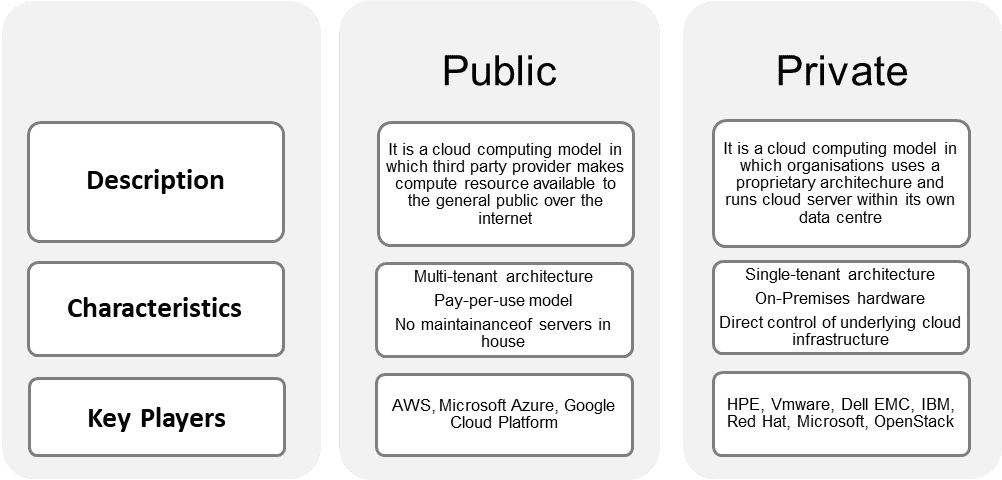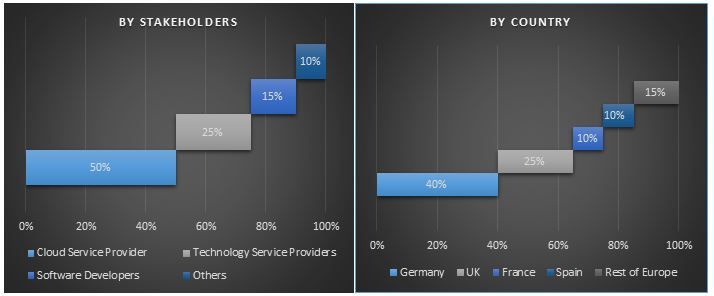- Home
- About Us
- Industry
- Services
- Reading
- Contact Us
Europe Market Insights on Cloud Infrastructure: Insights and Forecast, 2018-2024
Emphasis on Deployment Type (Public Cloud, Private Cloud), Public Cloud Services (SaaS, PaaS, IaaS, Cloud Advertising, BPaaS), End User (Banking, Financial Services and Insurance, Retail, Telecom & IT, Healthcare, Media & Entertainment, Government Agencies, Education, Energy, Manufacturing, Other Industries)
European Cloud infrastructure market has grown significantly. Skill shortage in Europe’s IT sector has created interesting opportunities for outsourcing. The current trend of ICT, namely cloud computing represents itself an evolution, wherein cloud contributes in many ways to accelerate technological innovation. Converging ICT developments in European region in recent years have significantly multiplied the choices available to users as well as suppliers of technology. Cloud technology has created innovative opportunities for both service providers and consumers of cloud services in Europe as the technology in Europe is characterized by being young, innovative, and vibrant and it showcases low barriers to entry. Cloud technology offers European firms the possibility to become market leaders. It enables the SME’s to build businesses and tap into computing power at low cost that previously required an upfront investment in ICT which was beyond their capacity.
Graphical Representation of Cloud Computing Deployment Model Analyzed in the Study
European Cloud Infrastructure Market garnered US XX Billion revenues and is anticipated to witness reasonable growth of 10% during the forecasted period (2018-2024). Adoption rate of cloud technology in Europe is set to display manifold increase in years to come primarily attributed to rapid maturity of cloud technology and dynamic and competitive IT environment. Cloud technology has progressively redefined the way it is utilized among the enterprises and end users especially in developed countries such as UK, Germany and France which is further projected to percolate into other countries namely Ireland, Austria and Finland. With the consistent maturity and standardization more and more companies are anticipated to adopt cloud technology hence foreseeing the benefits of the IT innovation. However, fragmentation of digital single market, transparency and data protection and integration capability pose some of the restraining parameters hampering the market potential.
Insights Presented in the Report:
- The report analyses the cloud Infrastructure service majorly for public and private deployment model in European region. To further add to the analysis the report also segments the market based on cloud infrastructure service, end user industry which is deployed in different country worldwide.
- The report analysis all the potential countries which has showcased increased deployment of cloud service over the last decade. Public and private cloud deployment model is further bifurcated into different services including public cloud (Software as a Service (SaaS), Platform as a Service (PaaS), Infrastructure as a Service (IaaS), Business process as a Service (BPaaS) and cloud advertising. Cloud advertising public cloud services dominated the market in 2017 with a market share of 44%.
- Private cloud deployment model is segregated into managed hosting and Co-Location and former held the maximum share in the cloud market of Europe. It has been estimated that Managed Hosting will grow at reasonable CAGR of 13% during the forecasted period.
- The report also analysis the different potential end-user industries who are most frequent adaptor and are most likely to be the likely to be the growth driver for the industry. Banking, Financial Services and Insurance, Retail industry, Telecom & IT, Healthcare, Media & Entertainment, Government agencies, Education, Energy and Manufacturing among others are the major end user industry analyzed during the study. In the Telecom & IT sector huge amount of data are generated owing to this, the sector has emerged as the largest adopter of cloud computing accounting for a market share of 17% in 2017.
- For better understanding of the geographical penetration of Cloud Service market in European region, the market is analyzed based on its outreach in the countries such as Germany, France, UK, Spain, Russia, Italy and rest of Europe. Germany holds one of the largest market share in the global cloud computing market accredited to advancing digitization in every aspect while France captures the second largest position in European cloud computing market primarily owing to mushrooming acceptance of cloud computing by new and emerging players paired with Small and Medium Enterprises. Moreover, United Kingdom has also gained prominence and constitutes as notable destination of cloud services among the enterprises due to huge customer base, advanced economy and absence of infrastructural bottlenecks. Germany cloud infrastructure market is expected to fetch US 22.0 Billion by 2024.
- European cloud computing market also provides competitive benchmarking of leading players in this market which includes profiling of companies such as Cisco System Inc., Equinix Inc., Google Inc., IBM Corporation, Salesforce.com, AT&T Inc., Amazon Web Services Inc., DXC Technology Company, HP Inc., and Rackspace Hosting Inc. These companies have been operating in this sector for several years and have diversified product portfolios, innovative technologies, and strong distribution networks worldwide.
Reasons to buy the Report:
- The study includes market sizing and forecasting analysis validated by authenticated key industry experts
- The report presents a quick review of overall industry performance at one glance
- The report covers in depth analysis of prominent industry peers with primary focus on key business financials, product portfolio, expansion strategies and recent developments
- Detailed examination on drivers, restraints, key trends and opportunities prevailing in the industry.
- Examination of industry attractiveness with the help of Porter’s Five Forces analysis
- The study comprehensively covers the market across different segments
- Deep dive regional level analysis of the industry
Customization Options:
The Europe cloud infrastructure Market can be customized to country level or any other market segment. Besides this, UMI understands that you may have your own business need, hence we also provide fully customised solutions to clients.
Table of Content
Analysing historical market, estimation of the current market and forecasting the future market for European Cloud Infrastructure services market were the three major steps involved in creating and analysing the overall market of the European Cloud Infrastructure Services Market. Exhaustive secondary research was conducted to collect the historical market of the technology and overall estimation of the current market. Secondly, to validate these insights, numerous findings and assumptions were taken into consideration. Moreover, exhaustive primary interviews were conducted with industry experts across value chain of the European Cloud Infrastructure Services Market. After all the assumption, market sizing and validation of market numbers through primary interviews, top-down approach was employed to forecast the complete market size of the European Cloud Infrastructure Services Market. Thereafter, market breakdown and data triangulation methods were adopted to estimate and analyse the market size of segments and sub-segments of the technology. Detailed methodology is explained below:
Analysis of Historical Market Size
Step 1: In-Depth Study of Secondary Sources:
Detail secondary study was conducted to obtain the historical market size of the European Cloud Infrastructure Services Market through company internal sources such as annual report & financial statements, performance presentations, press releases, inventory records, sales figures etc. and external sources including trade journals, news articles, government publications, competitor publications, sector reports, regulatory bodies publications, safety standard organizations, third-party database and other creditable publications.
Step 2: Market Segmentation:
After obtaining historical market size of the overall market, detailed secondary analysis was done to gather historical market insights and share for different segments & sub-segments for the European Cloud Infrastructure Services market. Major segments included in the report are public and private deployment model, cloud infrastructure service and end-user industry. Further analysis was also done for sub-segments of the major segments of the European Cloud Infrastructure Services market.
Step 3: Factor Analysis:
After acquiring the historical market size of different segments and sub-segments, detailed factor analysis was conducted to estimate the current market size of the European Cloud Infrastructure Services market. Factor analysis was conducted using dependent and independent variable such the preferences of deployment model type i.e. public and private, purchasing power of customers, security concern of data etc. Historical trends of the European Cloud Infrastructure Services market and its year-on-year impact on the market size and share in the recent past was analyzed. Demand and supply side scenario was also thoroughly studied.
Current Market Size Estimate & Forecast
Current Market Sizing: Based on actionable insights from the above 3 steps, we arrived at current market size, key players in major applications and markets, market shares of these players, industry’s supply chain, and value chain of the industry. All the required percentage shares, splits, and market breakdowns were determined using the above-mentioned secondary approach and were verified through primary interviews.
Estimation & Forecasting: For market estimation and forecast, weightage was assigned to different factors including drivers & trends, restraints, and opportunities. After analyzing these factors, relevant forecasting techniques i.e. Bottom-up/Top-down was applied to arrive at the market forecast pertaining to 2024 for different segment and sub-segments for the technology in major European countries. The research methodology adopted to estimate the market size encompasses:
- The industry’s market size, in terms of value (US$) and rate of adoption Cloud Infrastructure services in major European countries
- All percentage shares, splits, and breakdowns of market segments and sub-segments
- Key players in major applications and markets as well as market share of each players. Also, the growth strategies adopted by these players to compete in the ever-growing European Cloud Infrastructure Services market
Market Size and Share Validation
Primary Research: In-depth interviews were conducted with the Key Opinion Leaders (KOLs) including Top Level Executives (CXO/VPs, Sales Head, Marketing Head, Operational Head, and Regional Head etc.). Primary research findings were summarized, and statistical analysis was performed to prove the stated hypothesis. Input from primary research were consolidated with secondary findings, hence turning information into actionable insights.
Split of Primary Participants
Market Engineering
Data triangulation technique was employed to complete the overall market engineering process, to arrive at precise statistical numbers of each segment and sub-segment pertaining to the European Cloud Infrastructure Services Market. Data was split into several segments & sub-segments post studying various parameters and trends in the areas of Deployment Type i.e. Public or Private deployment. Public Cloud Services i.e., Software as a Service (SaaS), Platform as a Service (PaaS), Infrastructure as a Service (IaaS), Business process as a Service (BPaaS) and Cloud Advertising along with Private Cloud services i.e. Managed Hosting and Co-Location were considered while forecasting the market. Also detailed analysis of the technology in major industrial segment was also considered in the study.
Main objective of the European Cloud Infrastructure Services Market Study
The current & future market trends of the European Cloud Infrastructure Services market are pinpointed in the study. Investors can gain strategic insights to base their discretion for investments from the qualitative and quantitative analysis performed in the study. Current and future market trends would determine the overall attractiveness of the market, providing a platform for the industrial participant to exploit the untapped market to benefit as first mover advantage. Other quantitative goal of the studies includes:
- Analyse the current and forecast market size of the European Cloud Infrastructure Services market in terms of value (US$)
- Analyse the current and forecast market size of different segments and sub-segments of the European Cloud Infrastructure Services market
- Segments in the study include deployment type, public and private deployment, end-user industry and country
- Define and describe the technologies and protocols used in the European Cloud Infrastructure Services market
- Anticipate potential risk associated with the technology along with customer and competitor analysis, etc.
- Define and analysis of the government regulations for the European Cloud Infrastructure services market
- Analyse the current and forecast market size of European Cloud Infrastructure Services market for major European countries including Germany, France, UK, Spain, Russia, Italy and Rest of Europe
- Define and analyse the competitive landscape of the European Cloud Infrastructure Services market and the growth strategies adopted by the market players to sustain in the ever-growing market
Related Reports
Customers who bought this item also bought












